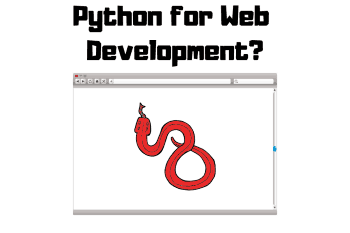Is Python Used for Web Development?

The basic concept of programming is to instruct “something” to perform some “tasks”. In that sense, computer programming denotes the way of telling the computer to do something (task(s) that the programmer wishes the machine to perform). Our surroundings are full of numerous gadgets and all of them are the result of programming.
Now, for telling the computer to do something, you need to talk with it. Programming languages are the media that fills in the gap. You can think of a programming language as the “bridge” between a programmer and the machine that enables the communication.
However, programming a program can be performed in numerous ways. Over the course of time, we’ve developed so many programming languages! Each of them offers different ways of writing code, a different philosophy, and different feature sets. Python is such a general-purpose programming language that offers tremendous power to the programmer to perform almost any task.
With the power of Python, we’re now performing amazing jobs. Python is being used in various fields – machine learning, data science etc. But how about web development? The field of web is becoming more and more dominant in the internet-driven world where every important operation is being performed on various servers. Moreover, people are relying more on web services for entertainment, education, relaxation, and others.
So, the question is obvious – is it possible to use Python for web development? Yes, Python is also used in web development. There are a number of Python frameworks for the web platform for web apps, database management, and other server-side applications. For example:
- Django
- Flask
- Pyramid
Python as a programming language
Are you interested in programming? Or, are you an experienced programmer? Then there’s a high chance that you’re already familiar with Python as a programming language. C and Python are taught as one of the primary programming languages in most of the programming courses.
Python is an interpreted, high-level programming language that targets code readability. With the powerful construct, it’s possible to integrate Python programming on both small and large scales.
Why not have a look at a pretty simple Python program?
# Store input numbers
number1 = input('Enter the first number: ')
number2 = input('Enter the second number: ')
# Sum up the numbers
sum = float(number1) + float(number2)
# Display the result
print('The sum of {0} and {1} is {2}'.format(number1, number2, sum))This code reads 2 number (number1 and number2) from the user and prints out the summation (number1 + number2) of them. If you look carefully, the code is quite self-explanatory. Anyone can figure out what’s going on, even the “zero-programming-experience” ones!
The history of Python is an interesting one. Developed by Guido van Rossum in the late 1980s, Python is the successor of the ABC language. The implementation of Python started its journey in December 1989. Since the release, we’ve come a long way in Python.
Now, there are 2 major Python versions you can use right now – Python 2.7.x and Python 3.x. In the case of Python 3.x, it’s not so good in terms of backward compatibility.
Python 2.7.x was supposed to retire in 2015. However, the date is changed. Now, Python 2.7.x is destined to retire next year (2020) and Python 3 is going to be the next standard Python.
Can you guess why the delay? Well, it’s because how popular the programming language is. The available programs written using Python 2.x is so huge that it was able to even slow down the retirement timing from 2015 to 2020 – 5 YEARS!
Python usage
Thanks to the maturity of the programming language, Python can be used in almost any type of situation! In fact, Python is the elder brother of Java – another popular, object-oriented programming language. With the incredible support from the community and maturity over time, the default library of Python allows it to do almost anything in the world! The only limiting factor here is the creativity of the programmer, I guess!

Python is such a programming language that offers multi-paradigm. You can think of it more like the Swiss knife of the coding world. Python can be used to perform object-oriented programming, functional and structured programming patterns and others. This gives the birth of the Python joke – Python is generally the second-best language for everything.
As you’ve guessed it, Python is used even in the higher echelon. For example, in the sector of data science and machine learning, Python is still the most popular language in this field! These are two of the most sectors with the highest demand.
Why not check out all the use case scenario of Python?
The article comes up with pretty straightforward information on Python – its usage, features, and other information. You also can get a nice comparison with the other well-known and popular programming languages like Java, C#, and Ruby etc.
Python for the web
Now, the question of the century – Python, for the web? Yes, it’s totally possible. In fact, the web platform is getting the benefit of Python for quite a long time. With maturity, there are numerous Python frameworks that work on the web platform with efficiency.
Why use Python for the web when there’re already other alternatives? Well, it all boils down to the following points.
- Ease – Python is one of the easiest programming languages you’re going to learn in your programming life. Many programmers start their career as a programmer with Python. The basic structure of Python is also super simple. Just take a look at the Python example code shared earlier in this article. That’s so easy that anyone could decipher it, right?
- Flexibility – Python offers a versatile platform for various programming paradigms like object-oriented programming, functional, imperative and even procedural programming.
- Productivity – It’s possible to develop complex ideas with Python without spending too much time on it. Creating a functional prototype is quite easy with Python. Python codes are also shorter than many other popular choices. For example, you can explain the same idea with Python in less code than C++, even 5-10 times shorter than in Java in most cases.
- Integration – Python can easily be integrated into other platforms and languages without breaking too much sweat. For example, you can integrate Python in C (CPython), Objective C (PyObjc), Java (JPython), Ruby (RubyPython), .NET (IronPython) and much more.
However, Python isn’t something like the mythical SECRET of everything. Despite being a good programming language, it still comes up with a few disadvantages.
- Speed limitation – Python is an interpreted language, meaning the performance will never be as fast as a compiled language like C++.
- Weak language for mobile and browsers – Python can be an excellent addition to the back-end. However, for the client side, it isn’t a good choice and doesn’t have so much implementation. It’s even more rarely used for smartphone-based applications. Even though there’s a way to do so (Brython), it’s not secure.
- Design restrictions – Python is dynamically typed. It also uses duck typing – if it looks like a duck, it must be a duck. This can raise some runtime error.
- Database access layers – Other programming languages offer powerful database technologies like JDBC (Java Database Connectivity) and ODBC (Open Database Connectivity). Python doesn’t come up with a strong database access layer. As a result, it is less used in the corporate world.
Python web frameworks
Despite the fact that Python isn’t so popular for web development, there are numerous frameworks that take advantage of the flexibility of Python for performing an amazing job.
Let’s have a look at the popular Python frameworks and their usage.
Django
Django is a high-level web framework that’s built by experienced developers. It reduces the stress on the programmer by reducing the number of things a programmer has to keep track of. It’s an open-source and free project.
Another thing Python isn’t adored for is its performance. With clever optimizations, Django increases the performance dramatically. Security is also tighter with Django. Django prevents various security threats, for example, SQL injection, cross-site request forgery, clickjacking etc.
With a powerful authentication system, it’s also easier to manage user accounts and passwords. Moreover, you’re getting loads of features right out-of-the-box, for example, site maps, RSS feeds etc.
Django is a widely used web framework that offers extreme scalability and versatility. Python is also used in numbers of situations to build all sorts of things – from CMS to social networks, scientific computing platforms and more. Here’s a short list of projects that enjoy the benefit from Django.
- YouTube – No need for an intro here. Originally based on PHP, the constant need for improving and adding new features without any issue made the platform to shift towards Django.
- Disqus – Disqus is one of the largest Django projects so far. It’s quite an easy-to-use plugin for comments.
- Instagram – The well-known image and video sharing site. Instagram also takes advantage of Django. Using the framework, Instagram is successfully maintaining its core principles – being simple, not reinventing the wheel and going with solid and proven techs.
Flask
Flask is a microframework for Python. The term “micro” is added before the framework because it doesn’t require any particular tool or library. It comes up with no database abstraction layer, form validation or any other components. For the common functions, it depends on the pre-existing 3rd-party libraries.
Flask is more commonly used with other frameworks like MongoDB. The main part is the versatility of Flask. There are numerous extensions available for Flask. Implementing those extensions is as if they were implemented in Flask itself.
With such versatility, you can easily manage other functions like form validation, object-relational mappers, upload handling and several common framework-related tools.
You can combine the power of Flask with Google App Engine as well.
Flask is used in various large projects.
- Flask – The official web page of Flask itself uses Flask.
- Pinterest – Another largely popular social media platform that offers sharing images, GIFs and videos.
- LinkedIn – Owned by Microsoft, LinkedIn is the hotspot for professionals and job seekers. It’s also the ultimate place for putting on your portfolio.
All of them are powered by Flask.
Pyramid
Web applications are of great importance in today’s world. With the help of Pyramid, it’s now easier to develop your own web application. Probably the best part of Pyramid is it supports all the Python versions (both Python 2.7.x and Python 3.x)!
Pyramid is a small, fast, down-to-earth Python framework for the web. It’s part of the Pylons Project.
The philosophy of Pyramid is to be just the size that gets the job done. The position of Pyramid is an in-between mega framework and microframework – not too small, not too heavy.
Here are some of the popular implementations of Pyramid.
- Mozilla – We all know Mozilla. Mozilla is a free software community that develops and spreads various Mozilla software – Firefox, Firefox OS, Thunderbird, SeaMonkey, Bugzilla etc.
- SurveyMonkey – One of the well-known platform for taking surveys. SurveyMonkey can help anyone to get the feedback they need to remodel their services.
Learning Python

Well, Python is a great language to master. Willing to get started?
There are numerous Python courses available on the internet. You can enjoy both free and paid courses on Python and become a master Python programmer in no time.
W3Schools: W3Schools is a great platform, especially for the beginners. All the tutorials in the site are free for everyone. Each and every single step in the complete tutorials are discussed in the easiest possible manner with clear explanations. You can learn Python and test your code online.
Get started with Python on W3Schools right now!
Codecademy: This is another awesome place for learning programming. Each of the programming courses is designed in such a manner that after completing every step, you’ll become a master in no time.
Each programming tutorial is separated into a number of lessons. Interestingly, without you understanding what is explained at the lesson, you won’t be able to progress further.
Get started with Python on Codecademy.
YouTube: We all love to spend hours after hours watching our favorite contents on the YouTube, right? Why not use this chance to improve yourself? Why not adding a new skill to your arsenal?
YouTube is crowded with some of the finest Python courses available, all for free! Here, I’ve collected some of my favorites – Learn Python – Full Course for Beginners and Zero to Hero with Python Programming.
Udemy: Need to train under expert care? Then Udemy is the right choice for you! Udemy offers thousands of courses on various subjects including Python! With training under an expert, you can easily develop your Python skill faster.
Here are a few Udemy courses on Python – Learn Python Programming Masterclass, Learn Python: Python for Beginners, The Complete Python 3 Course: Go from Beginner to Advanced!
Conclusion
Python is one of the finest programming languages to learn that you can implement in lots of real-life situations. Programming itself is a fun thing. With Python, let’s start your journey on the path of programming.
If you’re planning for having a career in programming, then Python is a must-have in your portfolio. It’s one of the basic requirements that you’ll find out in many job offers.
So, it’s a pretty good chance to learn Python right away. With all the available online resources, you can get started right at your home.
Enjoy!







